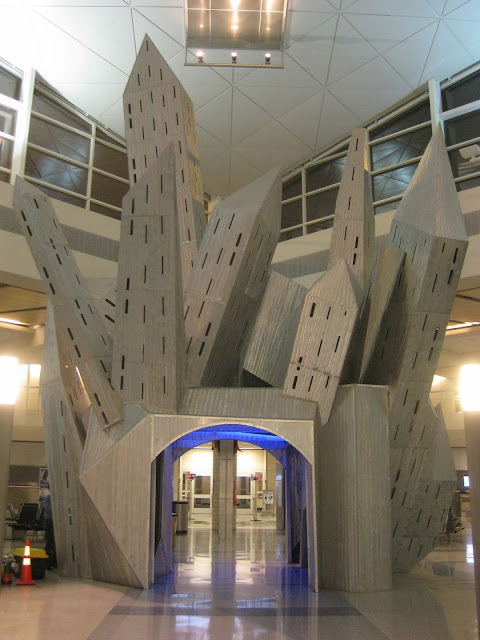 |
| The tunnel through Crystal Mountain sculpture at Terminal D. |
Time flies. [pun intended! ] Well it's been well over a year now since
Studio Six Art Conservation received the contract for the art maintenance and art conservation at the DFW International Airport Terminal D. As soon as the ink had dried and our security badges cleared, it's been go, go go!
Unlike the work Studio Six undertakes for many museums and private collections, the public sculpture at DFW is different because many of the artworks can be directly accessed by the public.
Works like the Crystal Mountain, shown here, designed by
Dennis Oppenheim and fabricated by
La Paloma Fine Arts is a two story tall structure with a tunnel through the middle. Formed of thick gauge welded sheets of stainless and accented with colored LED lights, this public sculpture is a huge draw for DFW passengers and employees alike.
While the metal sides have taken their fair share of hits from luggage carts, it's always a surprise to discover what trinkets or foodstuffs the traveling public leaves in the dark recesses of the tunnel. Half eaten candies, rubber bands, paper airplanes, even a few small stuffed animals... you can't help but wonder if the the artist considered this possible accumulation of bits while designing.
 |
| On 34 ft. boom lift, using a HEPA filter vacuum to remove the dust. |
And of course there's the dust. Tons of dust. When Studio Six first arrived on the job, so much dust had accumulated on the exterior peaks that it was beginning to look a bit like Spanish moss. It's amazing the amount of dust that accumulates on all of the artwork within Terminal D. A majority of it rides in on every person and bag that enters the terminal.
Of course these days Studio Six performs regular scheduled inspections of Crystal Mountain and regular dustings mostly done from an aerial lift using a HEPA vacuum. And there are routine cleanings that focus on the removal of surface grime left by hundreds of sticky fingers and hands.
 |
| Before the First BIG clean. |
 |
| After cleaning ... MUCH better. |

 Posted here are a few snapshots taken while Studio Six surface cleaned some of the public art on view at the DFW Airport.
Posted here are a few snapshots taken while Studio Six surface cleaned some of the public art on view at the DFW Airport.



